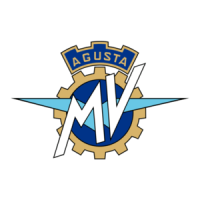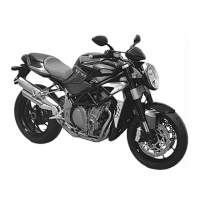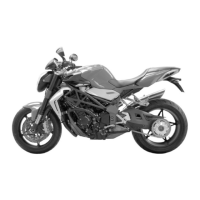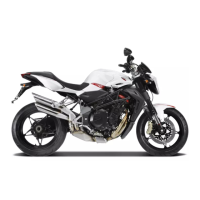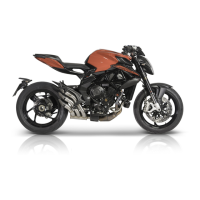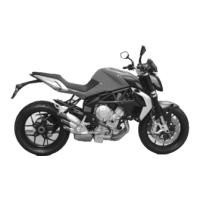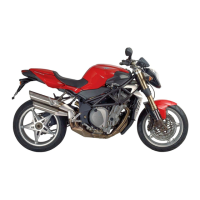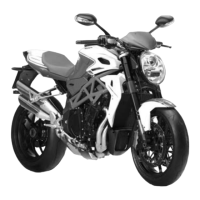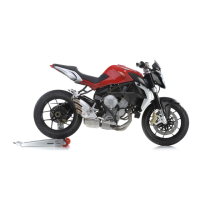Do you have a question about the MV Agusta Brutale 1090 and is the answer not in the manual?
Provides critical warnings about following instructions to avoid accidents, injury, or death.
Explains how to identify the motorcycle using VIN and engine serial numbers.
General safety guidelines and how to report safety-related defects.
Provides advice on rider experience, training, protective gear, and safe riding practices.
Outlines essential pre-ride checks for brakes, fluids, tires, and overall motorcycle condition.
Offers guidance on safe riding practices, gear selection, and speed management.
Specifies the maximum load capacity and warnings about overloading the motorcycle.
Diagram showing the placement of various controls and instruments on the motorcycle.
Details the functions of controls on the left handlebar, including turn signals and lights.
Describes the controls on the right handlebar, such as the starter, stop switch, and throttle.
Explains the ignition switch positions (ON, OFF, LOCK, P) and steering lock.
Overview of the instrument panel, including displays and warning lights.
Details the function and illumination of various warning lights on the instrument panel.
Provides basic information for correct motorcycle operation, including safety and performance.
Guidelines for the initial break-in period to ensure proper performance and longevity.
Instructions for starting the engine safely, including cold and hot start procedures.
Explains the immobilizer system, its function, and how to enter the secret code.
Details how the dashboard alerts the rider to faults or malfunctions during operation.
Provides instructions and warnings for safely refuelling the motorcycle.
Guidance on parking the motorcycle safely on firm, level ground and using the kickstand.
A comprehensive checklist of pre-ride inspections to ensure motorcycle reliability and safety.
Details adjustments for front suspension components: spring preload and damping.
Details adjustments for rear suspension components: rebound and compression damping.
Procedure for adjusting the headlight beam to the correct height and range.
Provides tables outlining periodic checks and maintenance operations for motorcycle safety.
Instructions on how to check the engine oil level and warnings about low oil.
Guidance on checking the coolant level and warnings about hot coolant.
Instructions on how to check brake pad wear and warnings about worn pads.
Guidance on checking the brake fluid level and ensuring it's between MAX and MIN marks.
Instructions for checking clutch fluid level and warnings about low fluid.
Advice on checking tire pressure, wear, and replacement procedures.
Flowchart to diagnose and resolve issues preventing the engine from starting.
Troubleshooting steps for an overheating engine, focusing on coolant and fuses.
Diagnoses low oil pressure issues when the warning light is illuminated.
Troubleshooting for non-functional lights, checking bulbs, fuses, and electrical systems.
Diagnoses issues with dashboard warning lights, checking fuses and battery.
Troubleshooting steps when the battery charge indicator remains on.
| Engine Type | Four cylinder, 4 stroke, 16 valve |
|---|---|
| Maximum Power | 106 kW (144 hp) at 10.300 r.p.m. |
| Maximum Torque | 112 Nm (11.4 kgm) at 8, 100 rpm |
| Cooling System | Liquid cooled |
| Transmission | 6-speed, constant mesh |
| Frame | Tubular steel trellis |
| Front Suspension | Marzocchi 'Upside Down' telescopic hydraulic fork with rebound-compression damping and spring preload external and separate adjustment |
| Rear Suspension | Progressive, single shock absorber with rebound and compression damping and spring preload adjustment |
| Front Brake | Double floating disc with 4-piston calipers |
| Rear Brake | Single steel disc with 4-piston caliper |
| Fuel Capacity | 23 liters |
| Dry Weight | 183 kg |
| Seat Height | 830 mm |
